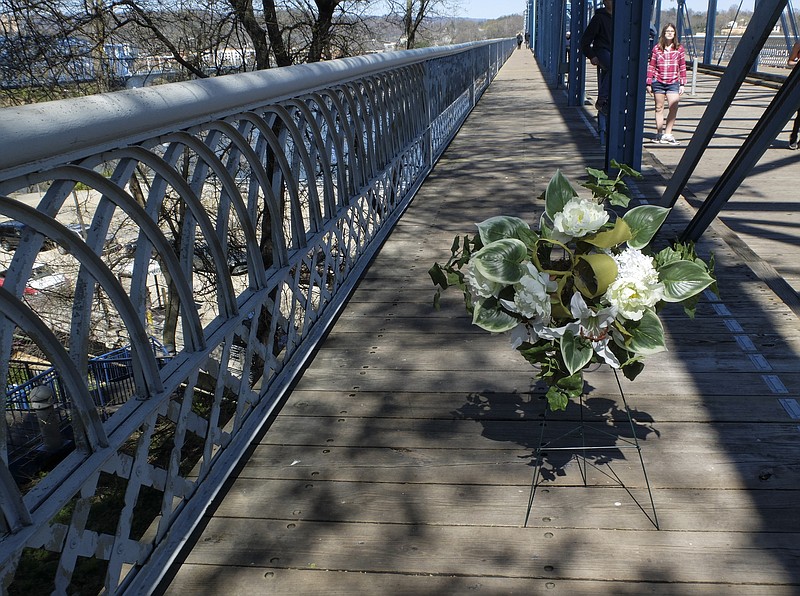Between 1885 and 1906, four black men were lynched in Chattanooga.
Charles Williams was hanged out of the third-floor window of the Hamilton County Jail by members of a mob of 1,000 white factory workers in the fall of 1885. Williams had been accused of shooting the assistant chief of police.
Alfred Blount was taken from his jail cell - the sheriff reportedly stepped aside - and lynched from the Walnut Street Bridge in the winter of 1897. Accused of assaulting a white woman, Blount was shot more than 100 times after the hanging and his body was viewed by 3,000 people as it hung for three hours in the cold night.
Charles Brown was hanged from a tree in the mining town of Soddy after being accused of assaulting the white daughter of a local farmer. He was lynched the same evening as Blount.
Ed Johnson was lynched from the Walnut Street Bridge in 1906 by a mob of 75 white men who broke into the jail and took him from his cell. He'd been accused of assaulting a white woman in St. Elmo.
"I am an innocent man," Johnson declared just before dying.
These four histories have been documented by the Equal Justice Initiative, a Montgomery, Ala., organization that has cataloged more than 4,000 lynchings in the post-Reconstruction South, including 233 in Tennessee.
Now, more than a century later, what do we, the living, owe these four dead men? Their families? Their communities?
In this time of hostility and racial anger, is it possible to dignify and memorialize them in a way that reconciles?
And unites?
Yes.
Meet the Ed Johnson Project.
"The Ed Johnson Project is not just about remembering the past and history, but finding ways to bring the community together," said Mariann Martin, a project member. "We want to tell history honestly, to acknowledge the terrible story, the attorneys and the legal precedent, but most of all, we want to create a better future for the community."
The Ed Johnson Project - created in 2016 with leadership from local educator LaFrederick Thirkill - has attempted to honor Johnson and his story: his brave lawyers, the U.S. Supreme Court's involvement, his own jail-house heroism. The project awards college scholarships, maintains Johnson's grave and performs Thirkill's play.
Its members are working to create a public memorial, and a documentary film on Johnson. (Bravo, Linda Duvoisin.) All summer, the project hosted local screenings with diverse crowds, including a recent event at Pilgrim Congregational Church.
"Some of the people who attended were an African-American family with two teenagers, a young couple who moved here from California two weeks ago, and a Canadian professor," said Martin. "All of them spoke after the film; many of them were in tears as they shared their stories and their hope that we could come together as a community and to be an example to the rest of the country of coming together despite our painful past."
That work continues this afternoon in one of the most meaningful public ceremonies in years. (Yes, you're invited.)
It's called a Soil Collection.
Beginning at the old county jail on Walnut Street at 2 p.m., the public group will gather soil from the Chattanooga ground, then carry it to the nearby bridge where Blount and Johnson were hanged. After eulogies for the four victims, the soil will be distributed among eight jars.
Four jars to remain here, representing the four men lynched.
And four jars to Montgomery.
There, the Equal Justice Initiative has begun a national library of soil from the 4,000 lynching sites. In 2018, it plans to open the first memorial in the U.S. honoring the victims of lynching.
View other columns by David Cook
The soil from Chattanooga will be part of that.
"Our goal isn't to be divisive," Equal Justice Initiative director Bryan Stevenson told The New York Times. "Our goal is just to get people to confront the truth of our past with some more courage."
Just days ago, as Sunday's program was being finalized, the Ed Johnson Project was able at the last-minute to confirm two more area lynchings.
Elridge Merrill, who in October 1873 was beaten, whipped and lynched in St. Elmo by a mob of white men angry over his relationship with a white woman.
Thomas Gailiff, taken from his home near Rossville Boulevard by a horde of Whitecappers - similar to the Ku Klux Klan - in July 1889. He was hanged near Rossville Gap for "traducing" - or slandering - women.
When we look deeply, we see that these lynched men are still with us, their ghosts in the trees and bridges of this city.
For decades, our city and county have ignored them.
How grateful we can be for the opportunity to now look upon their lives and deaths with dignity, respect and honor.
David Cook writes a Sunday column and can be reached at dcook@timesfreepress.com or 423-757-6329. Follow him on Facebook at DavidCookTFP.
